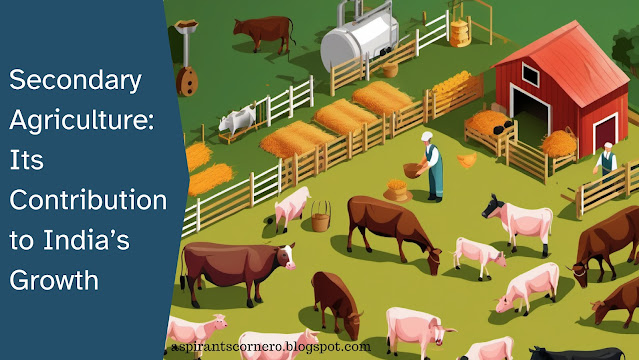Secondary Agriculture: Benefits, Challenges and Way Forward for Country's Growth
Secondary Agriculture: Its Contribution to Country's Growth
Secondary agriculture holds significant importance in India as it represents the crucial phase of value addition and processing in the agricultural value chain. This stage not only enhances the economic viability of the agricultural sector by providing additional income sources but also plays a pivotal role in rural development. The growth of agro-processing industries, gives India an opportunity to capitalize on the value inherent in its agricultural output, leading to increased employment opportunities and the development of ancillary services.
What is Secondary Agriculture?
Difference between Primary and Secondary Agriculture
Benefits of Secondary Agriculture
1) Increase in Income
Farmers and agricultural communities can benefit from secondary agriculture as it provides them diversified income sources as the processing of raw products leads to higher-value end products, creating economic resilience. Farmers can earn more by selling processed or value-added products compared to selling their raw produce. With a range of processed products, farmers are also less vulnerable to price fluctuations, have access to larger customer base, are able to brand and market their products which ensures a stable source of income.
2) Reduce Seasonal Unemployment
The problem of seasonal unemployment, associated with agricultural activities, will also be reduced with secondary agriculture as the development of secondary agriculture require a skilled workforce which will lead to job opportunities, human capital development and the empowerment of individuals in rural communities. The setting up of agro-processing units will create job opportunities in rural areas, ranging from skilled positions in processing to ancillary roles in packaging, transportation, and marketing, thereby boosting local employment.
3) Rural Industrialization
Secondary agriculture plays a pivotal role in catalysing rural industrialization and transforming agrarian economies by fostering the growth of processing industries and value-added enterprises. The growth of secondary agriculture necessitates infrastructure development, such as processing plants, storage facilities, transportation networks and also encourages the adoption of advanced technologies and modern processing methods, which contributes to overall rural development.
4) Women Empowerment
Secondary agriculture serves as a catalyst for women empowerment by providing them opportunities for economic participation, leadership roles, skill development, and the ability to contribute actively to the economic and social fabric of their communities. Women benefit from skill development initiatives, enhancing their capabilities and confidence, giving them chance to become agro-entrepreneurs.
5) Environmental Sustainability
Secondary agriculture plays a crucial role in fostering environmental sustainability by promoting efficient resource utilization, reducing waste, and integrating eco-friendly practices into the agricultural value chain. Through agro-processing and value addition, secondary agriculture helps in reducing post-harvest losses, ensuring that a larger percentage of harvested crops are utilized efficiently. The emphasis on processing and preservation also aligns with the principles of a circular economy, promoting the reuse and repurposing of agricultural by-products.
Challenges Faced by India in Secondary Agriculture
I. Lack of Trained Workforce:
A shortage of skilled labour proficient in modern processing techniques and quality control measures hampers the growth of secondary agriculture enterprises. Insufficient awareness and training programs for farmers and entrepreneurs in agro-processing limits the availability of skilled workforce required for the sector’s growth and innovation.
II. Infrastructure Deficiencies:
Insufficient infrastructure, including processing units, cold storage, transportation, access to modern technologies and credit facilities impedes the efficient growth of secondary agriculture. These absentees hinder the efficiency and competitiveness of secondary agriculture enterprises. Limited credit facilities becomes a challenge, especially for small and medium-sized enterprises who often struggle to have access to affordable credit to invest in modern technologies and scale up their operations. Difficulties in establishing effective market linkages and distribution channels also constrain the growth of processed agricultural products, limiting the market reach of secondary agriculture enterprises.
III. Financial Constraints:
Agro-processing often requires investment in modern technologies for efficient and scalable operations and financial constraints can act as a challenge for the adoption of these technologies, limiting productivity and competitiveness. Some enterprises may face challenges such as market limitations, or insufficient support for expansion due to financial constraints. An enterprise’s research and development activities for product innovation and process improvement can also get hampered as it requires financial investment to innovate and stay competitive. Financial constraints act as a barrier to the growth, efficiency, and resilience of secondary agriculture, impacting its overall contribution to economic development and sustainable agricultural practices.
Way Forward
- More skill development programs should be implemented to train and enhance the capabilities of the workforce engaged in agro-processing. This includes raising awareness about the processes, training in modern processing techniques, quality control, and efficient management practices.
- More focus should be given to facilitate affordable credit sources through low cost loans, financial incentives, subsidies, and grants to agro-processing enterprises which cater specifically to the needs of agro-processing units and encourage them to invest in modern technologies, infrastructure, and workforce development.
- More policies should be formulated which support the growth of secondary agriculture and improve their market access, facilitate infrastructural development, enhance organisational capacities and create agro-processing clusters.
By creating an enabling environment for the growth of secondary agriculture, India can harness it’s potential to facilitate rural development, employment generation, and increase the overall sustainability of the agricultural sector. The synergy between agriculture and industry in rural areas, driven by secondary agriculture, can not only boost income levels but also fosters overall economic development, leading to more resilient and sustainable rural communities.





Comments
Post a Comment